
|  |

|  |
e-mail: khokar1960@gmail.com The French connection December 31, 2018 Shakespeare's 'King Lear' in Kathakali by Annette Leday, which travelled all of last 2 months and toured India through 7 cities - Delhi, Chandigarh, Mumbai, Chennai, Ahmedabad, Trivandrum and Ranchi - is India's latest French connection. No, not the Rafael deal that makes occasional news but dance from France (it rhymes!), which is number one country for things Indian. Especially cultural. For long, the French are inspired by India as fodder for ballet (La Bayadere in 1800s), Lala Rookh / The Rose of Lahore (1900s) and since the 20th century invasion of France by Uday Shankar from 1930s onwards (whose 8th December birthday went unnoticed by even the dance fraternity, leave alone the nation) that continues by many French continuing to learn Indian art forms, especially classical dance. 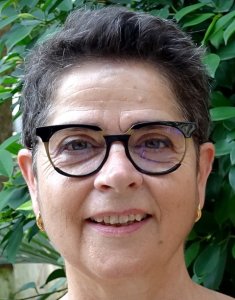 Annette Leday Milena Salvini came in 1960s to learn Bharatanatyam from senior Bharatanatyam guru M.K. Saroja, paving way for many more to come: Vidya, Shanti, Vani, Shalini, Jyoti (all adopted Indian names). Milena created Mandapa in Paris, which provided a great platform to many performing artistes plus teaching Indian music and dance, so much so that today, 50 years later it's the designated cultural center of the Indian Embassy in Paris too. Guru Saroja's guru bhai (as one, who learnt from the same guru, vidwan Muthukumaran Pillai of Kattumannar Koil bani) Muthuswami Pillai was in fact later known as French Guru in Madras! Many more local gurus in Delhi and Chennai started teaching to foreigners after the 70s. Annette Leday too came in 1970s but after exposure to Bharatanatyam, she decided to switch to very masculine Kathakali, not a woman's forte normally. For 40 years, she has been coming to India and hers is the most lasting of French connections. She did solo in the beginning, then partnered male dancers like Hariharan and now brought to India her work based on Shakespeare's work. Says Annette, "The idea of adapting King Lear came from David McRuvie, who co-directed the project with me. Kathakali and Elizabethan theatre are very different art forms. Adapting a Shakespeare play for Kathakali has similar problems and opportunities as say adapting a play for ballet or for opera - there will be loss and gain." What has 40 years of working with India meant? "My link to India, Indian arts and Indian artistes has filled up the most important part of my creative life. India has been a source of inspiration and a second home to me in many ways. Working with Kathakali artists has been extremely fulfilling in artistic as well as human terms. I have been working with a core team of 4, 5 dancers for the last 30 years in my different productions. I have been a witness of their lives and of their evolution as performers. A beautiful love story!" And where do you think is Indian dance going? "India certainly has the world's richest and most varied heritage in dance. From what I can see traditions seem to be kept alive all over, which is not an easy task in a country where all seems to be changing so rapidly. I sometimes feel that classical forms have been forced into a rushing sort of tempo that reduces the depth I remember having experienced some 40 years ago. I learnt first Bharatanatyam in Paris from visiting guru M.K. Saroja, then followed her to Madras where I met Dhananjayans too. Allow me also to mention I shifted to Kathakali because I fell in love with Kerala." So, after seeing dances in India, has Kathakali stood its ground and not changed much? "Kathakali is a very strong art form. The period of great gurus like Padmanabhan Nair, Keezhpadam Kumaran Nair whom I was very privileged to have as my teachers is over and as mentioned above times are different. The pattern and spirit of learning has changed a lot in the main institutions. Today artistes are required to have M.As and PhDs... But there have been lots of improvements too. Students are better considered and pampered. They have now a much better standard of life than before. Kathakali is one form with which few liberties have been taken by way of innovation and experimentation. We see the speed that has beset itself in Odissi, now Bharatanatyamised. Fast. The lyrical beauty gone. We see Kathak become Bollywood Kathak! We see many forms changing in character but thank god it's Friday and Kathakali has maintained its character. A vesham is still important; a solo elaboration intrinsic and the format untouched. Kerala must be complimented for maintaining standards in its traditional forms, just like Tamilnadu has." So, where does a foreigner stand in all this? That too, a lady in a nearly all-male bastion of Kathakali? In the centre. Because she is centred. She has understood the kernel truth of patra, characters and as in theatre or films, each needs individual development while being part of a whole. It took her 40 years to reach this state. For 20 years she visited every year just to learn the language. We rarely see that much invested, say when a Punjabi learns Odissi or Gujarati learns Manipuri. That's because, secretly we are brahmagyanis (and can't be taught anything!) 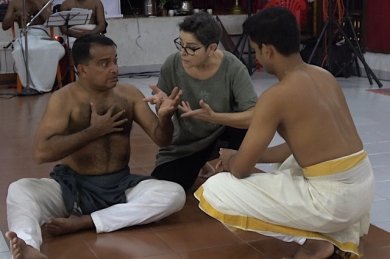 Rehearsal of 'King Lear' 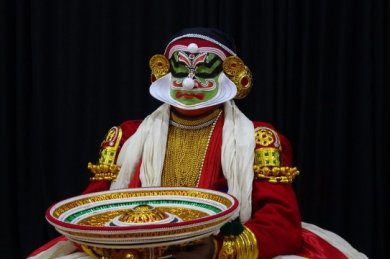 Kathakali 'King Lear' So Annette Leday takes cue from many masters of yore and dedicates these performances of Kathakali 'King Lear' to maestros Padmanabhan Nair, Keezhpadam Kumaran Nair, Vasudevan Namboodiripad and to Sadanam Krishnadas who died last year. She gets into the skin of the form, makes something tangible of a very intangible heritage and when she performs at The Globe in London (and recently in Chennai at Kalakshetra) then she is making a statement. Good art needs good manners too. Culture means being cultured first. The French are and truly so! Paris to Pune and reverse, that's senior Bharatanatyam guru Sucheta Bhide-Chapekar, whose 70th birthday on 6th December was celebrated on MES grounds with great fanfare. Not only her legion of students turned up from Nashik, Kolhapur, Sangli, Sholapur, Aurangabad, Bangalore and Pune but many veteran gurus came to bless too. Above 80 years young, these were gurus Dr. Kanak Rele, Prof. C.V. Chandrasekhar, Darshana Jhaveri and Sunaina Hazarilal who blessed the occasion. Each did their style with depth and meaning and wowed the audiences. It was a reference performance. By that, one means of historical relevance, as getting 2 veterans together on one stage in one city is an effort, getting 4 is a stroke of good luck! Arundhati Patwardhan and team provided an excellent, seamless support making it a memorable event and technical inputs were first rate. The over 2000 audience which stayed till end proved how our classical arts can reach the masses, not just classes. As this event might be covered in detail by other contributors who were present there I am not going into detailed description here, like a review. My columns are more about issues, not reviews. Dr. Kanak Rele next week was honoured by the Kerala govt. with the first Guru Gopinath Award, which was such a closed door ceremony in Delhi's Kerala Bhawan, with the CM no less in attendance and because of which no one could enter! People's party and people's money and people who love art could not attend due to tight security. Security of dancers has concerned me for long. Do you know that most have no medical insurance? Most don't plan and thus don't save for a rainy day. This was really true of a generation before, now the children and shishyas of aged gurus are wiser and do insure. The high honour - the Padma Awards - comes with no cheque but at least a CGHS linked medical coverage can be given. When each sarkari babu has this facility why not an artist, with or without an 'e'? For the many youngsters who don't read much except social media, 'artiste' is used for performing ones with an E at end (dance, music, drama) and without E at end denotes plastic or fine arts (that's painting, sculpture, graphics, film, design...). The SNA awards used to have medical insurance inbuilt but the premiums were so high that a former Secretary delinked it 10 years ago saying, "Why are we paying 85 lakhs in premium alone for all awardees, when we can pay same amount to those who really need, as and when?" The efficacy of this ad-hocism and arrangement is yet to be seen. 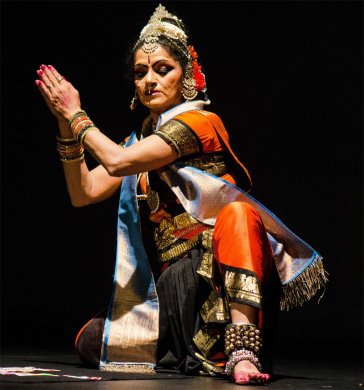 Vasundhara Doraswamy What was seen in Mysore was most yogic Bharatanatyam by senior talent Dr. Vasundhara Doraswamy, who at 70 can bend it like Beckham! Her body is like rubber with elasticity which can bend and stand without even her own hand support. Most dancers can't sit even in araimandi, forget sitting and performing on stage in a pose say like lying on seshanaga as in "Ranga...yen, palli kondeeraiyya?" Once they sit, they can't get up without wobbling. Not Vasundhara Doraswamy. She didn't even use an arm to support but just got up by sheer stamina and muscle power of knees and legs. 2 hours of non-stop solo dancing of a new work eulogising Amma, as in Devaki, Yashoda, even Poothana and she did not once breathe heavily! No sweat, no huffing and puffing which 25 year olds do today after one opening item. Her abhinaya was so polished and mesmerizing that one forgot in places it was a performance. It was complete identification with the role. And then one sees clones. So what are teachers teaching today? Items? Not really an art form. Dr. Doraswamy had training in yoga first under iconic Pattabhi Jois, then dance. She has sustained her art without rewards or even an SNA award (how 50-year-olds get one and not someone who has danced 50 years and is nearing 70 years, beats me). Something is terribly wrong with most awards per se. Who sits and decides fate of fellow artistes? Are they about groups or gangs or about art? Do they have any consideration for good, sustained innings or just star appeal or personal considerations ('I like his nose or her eyes' or 'her guru touched my feet at last function and he didn't' syndrome)? Where is our value system in art and society going? 50 years is a long time to think and Guru Radha Shridhar of Bangalore has been doing that but neither got a Padma nor an SNA yet. But at 80, does that lessen her output? No way. She has trained 3 generations of dancers and more. Each one a shining example of good foundation and perfection. Her star disciple Aishwarya Nityananda was selected by India Today 5 years ago as under 30 potentials in dance. Bianca Radhakrishna is another budding talent. Add Guru Radha's daughters in USA and students abroad, who are platformed every December end at a mammoth Rasa Sanje festival of 3 days, where Shadakshari conducts with poetic beauty and many like Shankar Kandaswamy get standing ovation, for exceptional shringar rasa infused dancing. He was meant for dance and dance for him. Sophia Salingaros of San Antonio and benign acharya Sreedhara Akkihebbalu's student showed obvious ballet background but was first rate, even with little attitude while Rashmi Iyengar had a poor sound track and no real defining quality about her dancing. Her face was expressive and maybe being a TV serial actress, she is more suited to that. Neha Kuderu stands tall - literally at 6 feet! - but is soft in delivery and supple. Reminds me of Yamini Krishnamurthy when she was her age. Aparna, Divya, Deepti, Sindhu - other disciples of guru Radha Shridhar - did her proud. Guru Shridhar's Venkatesha Natya Mandir showcased three generations of dancers she has helped train. That alone deserves an award. Ageing dancers need special care. I am dealing with such a situation at home with my mother, guru M.K.Saroja, now 88. I shifted south from Delhi 20 years ago, at peak of my career, to serve my parents and learn in depth of dance heritage and history from them. By chance, I got opportunity to then look after my cancer-bound father, so being time bound, I recorded over 100 hours of tapes from the most authentic, important and direct dance source of our history. These are most valuable tools for reconstruction now and writing of our dance history as comes from an impeccable source with much field work. So talking of dance matters, do we have a single facility for veterans who have no family? Ritha Devi died alone and her son within 6 months of her dying. Her flat in Pune is now taken over by the state because the son left no will. All her costumes and books fortunately he donated to MKDC when he last met me in Pune, which is now my 5th home! But I have no paper trail. In good Indian fashion it was verbal. Besides, who would think he will die at 60+? 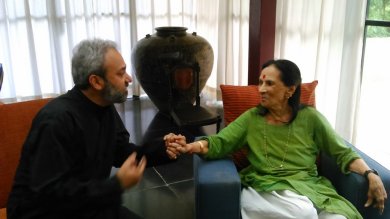 Ashish Khokar with Mrinalini Sarabhai Another matter that concerns me while attending 200 shows in 365 days (and occasionally chief guesting) is the sheer wastage that goes in giving of shining, cheap shawls that can't be worn again; flowers that wilt within an hour and an often ghastly trophy one can't take home! The great Mrinalini Sarabhai once showed me a whole wall of such trophies at home in Darpana, Ahemdabad, and said, "Ashish, if only each organiser had given a silver coin I could melt and use to make costume jewellery or on a rainy day but what do I do with these?" A most genuine comment. She was the most gracious dancer, guru, diva one came across in my nearly 60 years. Yes, vision 2020, I will reach that goal, although by my leap year birthday I'd just turn 14! Thinking of which, as a child, a real one at 14, I wrote to my father's BN guru, the redoubtable athai Rukmini Devi: Since I'm born on same date as you, will I become great too?!! Imagine the cheek of a 14 year old and imagine her greatness when she made time and replied to a pesky teenager: 'Dear Ashish, greatness is not important; do good work and your work will speak for itself. You are my Mohan and Saroja's son; that's great in itself!' Above are all 'dance matters' and to show how much (or less) dance matters in Indian society. Where it stands as value addition, moola mantra, or mere usage and branding. The term is play on words I so love and coined for NKC (that's Natya Kala Conference in Chennai every December end, for rest of India) over ten years ago, when the dynamic dancer-activist Ananda Shankar Jayant was the convenor. Since then others have used this term and some abused it too! I'm happy to use it here for my new column that will cover many such issues in the dance field. If you have an important concern, do send my way to explore and platform if I find it has a wider appeal and is a non-personal agenda. Let's serve the field more than our petty egos. Recall what Athai said! 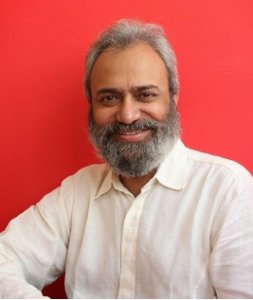 Ashish Mohan Khokar is a senior critic and historian with interest in cultural policy, international exchange and helps dance in many ways. He edits attendance and mentors many. Comments * Brilliant article! Very refreshing to see strong independent views from senior learned critics. Keep up the great work. - Anon (Jan 1, 2019) Post your comments Please provide your name and email id when you use the Anonymous profile in the blog to post a comment. All appropriate comments posted with name & email id in the blog will also be featured in the site. |